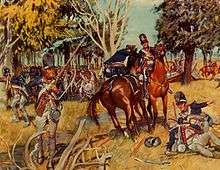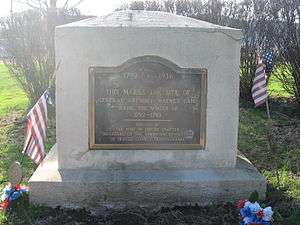Legion of the United States
| Legion of the United States | |
|---|---|
 Major General Anthony Wayne with the Legion of the United States, 1794 | |
| Active | 1792-1796 |
| Country | United States of America |
| Branch | U.S. Army |
| Type | frontier army, recruited and formed in Pittsburgh, Pennsylvania |
| Role | pacify the Native-American tribes and make the western frontier safe for settlement |
| Size | 5,120 total strength |
| Part of | composed of four sub-legions, each commanded by a lieutenant colonel. Sub-legions were self-contained units with two battalions of infantry, a rifle battalion (light infantry skirmishers armed with Pennsylvania long rifles to screen the infantry), a troop of dragoons and a battery of artillery. |
| Colors |
Unit Colors: 1st Sub-Legion: white and black 2nd Sub-Legion: red and white 3rd Sub-Legion: black and yellow 4th Sub-Legion: green and white |
| Engagements | Siege of Fort Jefferson, June 5, 1792-1795, Siege of Fort Recovery, June 30, 1794, Battle of Fallen Timbers, August 3, 1795, in the Northwest Indian War |
| Disbanded | After 1796, the 1st, 2nd, 3rd and 4th Sub-Legions were reformed and designated the 1st, 2nd, 3rd and 4th Regiments of the United States Army |
| Commanders | |
| Current commander | Major General Anthony Wayne |
| Ceremonial chief | Brigadier General James Wilkinson, second-in-command |
The Legion of the United States was a reorganization and extension of the United States Army from 1792 to 1796 under the command of Major General Anthony Wayne.[1]
Origins
The impetus for the legion came from General Arthur St. Clair's disastrous defeat at the Battle of the Wabash by Blue Jacket and Little Turtle's tribal confederacy in November 1791. The Founding Fathers had been suspicious of standing armies, believing that the militia would be suited to all the nation's defensive needs. However, the defeat of St. Clair and his predecessor, Josiah Harmar, whose forces were drawn principally from state militias, caused a shift in thinking. President Washington drafted a list of sixteen general officers from the American Revolutionary War to lead an expanded Army in the Northwest, including Benjamin Lincoln, Daniel Morgan, and Friedrich Wilhelm von Steuben. After consulting with his cabinet, he picked Wayne to lead the new professional army, although Washington originally considered him too vain.[2] At the recommendation of Secretary of War Henry Knox, it was decided to recruit and train a "Legion" — i.e., a force that would combine all land combat arms of the day (cavalry, heavy and light infantry, artillery) into one efficient brigade-sized force divisible into stand-alone combined arms teams. Congress agreed with this proposal and agreed to augment the small standing army until "the United States shall be at peace with the Indian tribes."
Structure
The legion was composed of four sub-legions, each commanded by a lieutenant colonel.[3] These sub-legions were self-contained units with two battalions of infantry, a rifle battalion (light infantry skirmishers armed with Pennsylvania long rifles to screen the infantry), a troop of dragoons and a battery of artillery.[4] With their combined arms organization, the sub-legions can be seen as forerunners of today's brigade combat teams.
The legion was recruited and raised in Pittsburgh, Pennsylvania. It was eventually divided into four sub-legions. These were created from elements of the 1st and 2nd Regiments of the US Army. These units then became the First and Second Sub-Legions. The Third and Fourth Sub-Legions were raised from further recruits. From June 1792 to November 1792, the legion remained cantoned at Fort LaFayette in Pittsburgh.
The legion then moved to the United States Military's first basic training facility at Legionville in western Pennsylvania on the banks of the Ohio River. The frontier fort was built on the orders of General Anthony Wayne. General Wayne also established various forts along his line of march to ensure adequate re-supply, and garrisoned these forts with freshly trained legionnaires.
Battles
The Legion of the United States was engaged in several attacks on their convoys as the expedition pushed further into Native American strongholds, chiefly towards the Maumee Rapids. For a period of three years, starting on June 25, 1792, Fort Jefferson, along with the Legion ammunition supply trains en route to the fort, were under constant siege by native forces. On June 30, 1794, just outside the gates of Fort Recovery, built on St. Clair's battlefield, now present-day Fort Recovery, Ohio, a pack-horse convoy, led by Major William Friend McMahon, of Yellow Springs, Ohio, was attacked by 2,000 Native Americans. After Major McMahon was killed and the rest of the survivors fled to the protection within the fort, a full-scale attack was made on the fortification. Fortunately, for the defenders, most of the men, approximately 125 soldiers, were expert riflemen. Fort Recovery also had artillery support to back them up. The battle raged for two days, but the fort was never taken. Some scholars believe there were more native warriors involved in the attack of Fort Recovery than at the climatic Battle of Fallen Timbers.

The most notable engagement in which the legion participated was the Battle of Fallen Timbers, near present-day Toledo, Ohio. As the legion's front was attacked by the Indians, the troops closed quickly and pressed with the bayonet. The Indian forces could not hold the force of the legion's attack and broke and ran. The British in Fort Miami refused to open the gates and the survivors were essentially on their own. Although a short battle, Fallen Timbers was the culmination of an arduous campaign and owes its success to the intense training and discipline of the Legion of the United States.
The legion by its very concept was formed and trained from its early days in Pittsburgh, Pennsylvania to fight in a woodland environment. Each sub-legion had its own attached artillery, dragoons and riflemen, light and heavy infantry. Officers, sergeants and enlisted personnel were trained to fight in small units and were used to being geographically separated and fighting on their own. General Anthony Wayne's tactics were to fire and move quickly with the light infantry as his front line forces supported by heavy infantry. The legion was taught to move quickly on the enemy so he could not re-load, then attack with bayonets. This was the whole design and concept of the legion. By August 20, 1794, the Legion of the United States had trained for over 25 months for this battle and was a finely honed machine. The success of the legion is owed mostly to General Wayne, but also to George Washington and Henry Knox.
On August 3, 1795, as a result of the Battle of Fallen Timbers, the Native Americans signed the Treaty of Greenville, ending the war with the United States.
In 1796, Major General Anthony Wayne accepted surrender of all the British forts, including Fort Niagara and Fort Miami that were located illegally within the United States in violation of the Treaty of Paris (1783). The legion also entered the Native American stronghold of Kekionga, which was the goal of the ill-fated St. Clair campaign. The legion built strong fortifications in the town and named it Fort Wayne, in honor of their commanding general.
Thus ended the mission of the legion which had begun in June 1792.
Legacy

It is a common misconception that the legion was abandoned in 1796. After the death of General Anthony Wayne in Erie, Pennsylvania on December 15, 1796, his second-in-command, Brigadier General James Wilkinson (later found to be a spy for the Spanish government) tried to rid the army of everything Wayne had created including the legionary structure of the army. Thus the 1st, 2nd, 3rd and 4th Sub-Legions became the 1st, 2nd, 3rd and 4th Regiments of the United States Army.
The coat of arms for the 1st U.S. Infantry Regiment shows part of the shield in red in honor of the 2nd Sub-Legion. The 1st Inf Regiment is descended from the 2nd Regiment U.S. Army.
The Distinctive Unit Insignia worn on the epaulette of the 3rd U.S. Infantry, also known as "The Old Guard", is a gold-colored metal device that shows "an Infantry officer's cocked hat of 1784 with plume."[5] This alludes to the crest of the 3rd Infantry Regiment's coat of arms, which shows a black cocked hat with white plume. These are the colors of the 1st Sub-Legion. An example of a similar hat can be seen in the uniforms of the 3d Infantry Regiment's Fife and Drum Corps[6]
The coat of arms of the 4th U.S. Infantry Regiment is green and white in honor of the 4th Sub-Legion.
Unit Colors:
- 1st Sub-Legion: White and Black
- 2nd Sub-Legion: Red and White
- 3rd Sub-Legion: Black and Yellow
- 4th Sub-Legion: Green and White
See also
- Coats of arms of U.S. Infantry Regiments
- Combined arms
References
- ↑ Kochan, James (2001). United States Army 1783-1811 (Men-at-Arms Series). Osprey Military. pp. 13–15. ISBN 1-84176-087-0.
- ↑ Sword, Wiley (1985). President Washington's Indian War. The Struggle for the Old Northwest, 1790-1795. Norman, Oklahoma: University of Oklahoma Press. p. 205. ISBN 0806124881.
- ↑ Field Officers of the Sub-Legions
- ↑ Organization of the Legion
- ↑ "3d Infantry Regiment". The Institute of Heraldry. The Institute of Heraldry. Retrieved 4 February 2015.
- ↑ "Press Materials". The Old Guard Fife and Drum Corps. Retrieved 4 February 2015.